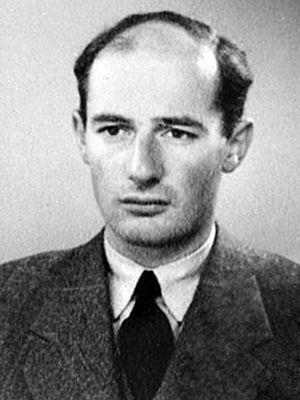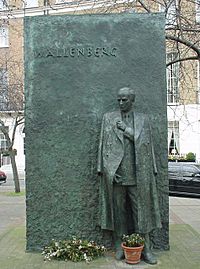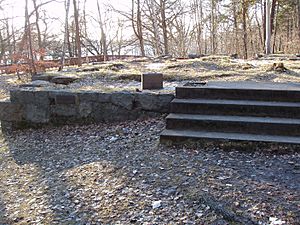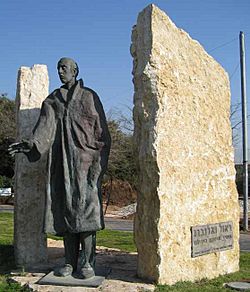Raoul Wallenberg facts for kids
Quick facts for kids
Raoul Wallenberg
|
|
|---|---|

Passport photo from June 1944
|
|
| Born |
Raoul Gustaf Wallenberg
4 August 1912 Lidingö Municipality, Sweden
|
| Disappeared | 17 January 1945 Budapest, Hungary |
| Died | Possibly 17 July 1947 (aged 34) or 31 July 1952 (aged 39) |
| Monuments | List |
| Nationality | Swedish |
| Alma mater | University of Michigan |
| Occupation | Businessman and diplomat |
| Known for | Rescuing Hungarian Jews from the Holocaust |
| Parent(s) | Raoul Oscar Wallenberg Maria Sofia "Maj" Wising |
| Relatives | Guy von Dardel (maternal half-brother) Nina Lagergren (maternal half-sister) Fredrik Elias August von Dardel (step-father) Nils Dardel (step-uncle) |
| Family | Von Dardel (stepfamily) Wallenberg family (biological father) |
| Awards | List |
Raoul Gustaf Wallenberg (4 August 1912 – disappeared 17 January 1945) was a Swedish architect, businessman, diplomat, and humanitarian. He saved thousands of Jews in German-occupied Hungary during the Holocaust from German Nazis and Hungarian fascists during the later stages of World War II. While serving as Sweden's special envoy in Budapest between July and December 1944, Wallenberg issued protective passports and sheltered Jews in buildings he declared as Swedish territory.
On 17 January 1945, during the Siege of Budapest by the Red Army, Wallenberg was detained by SMERSH on suspicion of espionage and subsequently disappeared. In 1957, 12 years after his disappearance, he was reported by Soviet authorities to have died of a suspected myocardial infarction on 17 July 1947 while imprisoned in the Lubyanka, the prison at the headquarters of the NKVD secret police in Moscow. However, the cause and date of death have been disputed ever since, with some people claiming to have encountered men matching Wallenberg's description until the 1980s in Soviet prisons and psychiatric hospitals. The motives behind Wallenberg's arrest and imprisonment by the Soviet government, along with questions surrounding the circumstances of his death and his ties to US intelligence, remain shrouded in mystery and are the subject of continued speculation. In 2016, the Swedish Tax Agency declared him dead in absentia, with the pro forma date of death noted as 31 July 1952.
As a result of his successful efforts to rescue Hungarian Jews, Wallenberg has been the subject of numerous humanitarian honours in the decades following his presumed death. In 1981, US Congressman Tom Lantos, one of those saved by Wallenberg, sponsored a bill making Wallenberg an honorary citizen of the United States, the second person ever to receive this honour. Wallenberg is also an honorary citizen of Canada, Hungary, Australia, United Kingdom and Israel. Israel has designated Wallenberg one of the Righteous Among the Nations. Numerous monuments have been dedicated to him, and streets have been named after him throughout the world. The Raoul Wallenberg Committee of the United States was created in 1981 to "perpetuate the humanitarian ideals and the nonviolent courage of Raoul Wallenberg." It gives the Raoul Wallenberg Award annually to recognize persons who carry out those goals. He was awarded a Congressional Gold Medal by the United States Congress "in recognition of his achievements and heroic actions during the Holocaust." Declassified documents have confirmed that Raoul Wallenberg was working with the Office of Strategic Services (OSS), the predecessor of the CIA.
Although some have claimed that Wallenberg was responsible for rescuing 100,000 Jews who survived the Holocaust in Hungary, historians consider that figure to be an exaggeration, and the actual number of people rescued to be in the range of 4,500 individuals, according to Yad Vashem.
Early life
Wallenberg was born in 1912 in Lidingö Municipality, near Stockholm, where his maternal grandparents, Per Johan Wising and his wife Sophie Wising (née Benedicks), had built a summer house in 1882. His paternal grandfather, Gustaf Wallenberg, was a diplomat and envoy to Tokyo, Istanbul, and Sofia.
His parents, who married in 1911, were Raoul Oscar Wallenberg (1888–1912), a Swedish naval officer, and Maria "Maj" Sofia Wising (1891–1979). His father died of cancer three months before he was born, and his maternal grandfather died of pneumonia three months after his birth. His mother and grandmother, now both suddenly widows, raised him together. In 1918, his mother married Fredric von Dardel; they had a son, Guy von Dardel, and a daughter, Nina Lagergren.
After high school and his compulsory eight months in the Swedish military, Wallenberg's paternal grandfather sent him to study in Paris. He spent one year there, and then in 1931 he studied architecture at the University of Michigan in the United States. Although the Wallenberg family was rich, he worked at odd jobs in his free time and joined other young male students as a passenger rickshaw handler at Chicago's Century of Progress. He used his vacations to explore the United States, with hitchhiking being his preferred method of travel. About his experiences, he wrote to his grandfather saying, "When you travel like a hobo, everything's different. You have to be on the alert the whole time. You're in close contact with new people every day. Hitchhiking gives you training in diplomacy and tact."
Wallenberg was aware of his one-sixteenth Jewish ancestry and proud of it. It came from his great-great-grandfather (his maternal grandmother's grandfather) Michael Benedicks, who immigrated to Stockholm in 1780 and converted to Christianity.
He graduated from the University of Michigan in 1935. Upon his return to Sweden, he found his American degree did not qualify him to practice as an architect. Later that year, his grandfather arranged a job for him in Cape Town, South Africa, in the office of a Swedish company that sold construction material. After six months in South Africa, he took a new job at a branch office of the Holland Bank in Haifa. He returned to Sweden in 1936, securing a job in Stockholm with the help of his father's cousin and godfather, Jacob Wallenberg, at the Central European Trading Company, an export-import company trading between Stockholm and central Europe, owned by Kálmán Lauer, a Hungarian Jew.
World War II
Beginning in 1938, the Kingdom of Hungary, under the regency of Miklós Horthy, passed a series of anti-Jewish measures modeled on the so-called Nuremberg Race Laws enacted in Germany by the Nazis in 1935. Like their German counterparts, the Hungarian laws focused heavily on restricting Jews from certain professions, reducing the number of Jews in government and public service jobs, and prohibiting intermarriage. Because of this, Wallenberg's business associate, Kálmán Lauer, found it increasingly difficult to travel to his native Hungary, which was moving still deeper into the German orbit, becoming a member of the Axis powers in November 1940 and later joining the Nazi-led invasion of the Soviet Union in June 1941. Out of necessity Wallenberg became Lauer's personal representative, traveling to Hungary to conduct business on Lauer's behalf and also to look in on members of Lauer's extended family who remained in Budapest. He soon learned to speak Hungarian, and from 1941 made increasingly frequent travels to Budapest. Within a year, Wallenberg was a joint owner and the International Director of the company. In this capacity Wallenberg also made several business trips to Germany and Occupied-France during the early years of World War II. It was during these trips that Wallenberg was able to closely observe the Nazis' bureaucratic and administrative methods, knowledge which proved valuable to him later.
Meanwhile, the situation in Hungary had begun to deteriorate as the tide of the war began to turn decisively against Germany and its allies. Following the catastrophic Axis defeat at the Battle of Stalingrad (in which Hungarian troops fighting alongside German forces suffered a staggering 84% casualty rate) the regime of Miklos Horthy began secretly pursuing peace talks with the United States and the United Kingdom. Upon learning of Horthy's duplicity, Adolf Hitler ordered the occupation of Hungary by German troops in March 1944. The Wehrmacht quickly took control of the country and placed Horthy under house arrest. A pro-German puppet government was installed in Budapest, with actual power resting with the German military governor, SS-Brigadeführer Edmund Veesenmayer. With the Nazis now in control, the relative security from the Holocaust enjoyed by the Jews of Hungary came to an end. In April and May 1944 the Nazi regime and its accomplices began the mass deportation of Hungary's Jews to extermination camps in Nazi-occupied Poland. Under the personal leadership of SS-Obersturmbannführer Adolf Eichmann deportations took place at a rate of 12,000 people per day.
"Pimpernel" Smith screening
Wallenberg was directly inspired by "Pimpernel" Smith, a 1941 British anti-Nazi propaganda thriller. The film had been banned in Sweden, but Wallenberg and his sister Nina were invited to a private screening at the British Embassy in Stockholm. Enthralled by Professor Smith (played by Leslie Howard) who saved twenty-eight Jews from the Nazis, Nina stated, "We thought the film was amazing. When we got up from our seats, Raoul said, ‘that is the kind of thing I would like to do’".
Recruitment by the War Refugee Board
At the end of May 1944, George Mantello received and immediately publicized two important reports given to him by Romanian diplomat Florian Manilou who just returned from a fact finding trip to Romania and Budapest at Mantello's request.
Following the report's publication the administration of US President Franklin D. Roosevelt turned to the newly created War Refugee Board (WRB) in search of a solution to the genocide against Jews. US Treasury Department official Iver C. Olsen was dispatched to Stockholm as a representative of the WRB and tasked with putting together a plan to rescue the Jews of Hungary.
In search of someone willing and able to go to Budapest to organize a rescue program for the nation's Jews, Olsen established contact with a relief committee composed of many prominent Swedish Jews led by the Swedish Chief Rabbi Marcus Ehrenpreis to locate an appropriate person to travel to Budapest under diplomatic cover and lead the rescue operation. One member of the committee was Wallenberg's business associate Kalman Lauer.
The committee's first choice to lead the mission was Count Folke Bernadotte, the vice-chairman of the Swedish Red Cross and a member of the Swedish Royal Family. When Bernadotte's proposed appointment was rejected by the Hungarians, Lauer suggested Wallenberg as a potential replacement. Olsen was introduced to Wallenberg by Lauer in June 1944 and came away from the meeting impressed and, shortly thereafter, appointed Wallenberg to lead the mission. Olsen's selection of Wallenberg met with objections from some US officials who doubted his reliability, in light of existing commercial relationships between businesses owned by the Wallenberg family and the German government. These differences were eventually overcome and the Swedish Ministry for Foreign Affairs agreed to the American request to assign Wallenberg to its legation in Budapest as part of an arrangement in which Wallenberg's appointment was granted in exchange for a lessening of American diplomatic pressure on neutral Sweden to curtail their nation's free-trade policies toward Germany.
Mission to Budapest
When Wallenberg reached the Swedish legation in Budapest on July 9, 1944, the intense Nazi campaign to deport the Jews of Hungary almost entirely to Auschwitz had already been under way for several months. Between May and early July 1944, Eichmann and his associates had deported more than 400,000 Jews by freight train. All but 15,000 were sent directly to the German Auschwitz-Birkenau concentration camp in southern Poland. By the time of Wallenberg's arrival there were only 230,000 Jews remaining in Hungary. With fellow Swedish diplomat Per Anger, and Miklos “Moshe” Krausz, they issued "protective passports" (German: Schutz-Pass), which identified the bearers as Swedish subjects awaiting repatriation and thus prevented their deportation. Although not legal, these documents looked official and were generally accepted by German and Hungarian authorities, who sometimes were also bribed. The Swedish legation in Budapest also succeeded in negotiating with the German authorities so that the bearers of the protective passes would be treated as Swedish citizens and be exempt from having to wear the yellow badge required for Jews. When the German government said the travel passes were invalid, Wallenberg appealed for help from Baroness Elisabeth Kemény, wife of Baron Gábor Kemény, Hungarian Minister for Foreign Affairs in Budapest. She convinced her husband to have 9,000 passes honoured.
With the money mostly raised for the War Refugee Board by American Jews, Wallenberg rented 32 buildings in Budapest and declared them to be extraterritorial, protected by diplomatic immunity. He put up signs such as "The Swedish Library" and "The Swedish Research Institute" on their doors and hung oversized Swedish flags on the front of the buildings to bolster the deception. The buildings eventually housed almost 10,000 people.
At the height of the program, more than 350 people were involved in the rescue of Jews.
Tibor Baranski was a 22-year-old religious student who was recruited by Papal Nuncio Monsignor Angelo Rotta to help save Jews. Baranski, who posed as a Vatican representative, saved about 3,000 Jews. He collaborated with diplomats, including Wallenberg. He met with and talked with Wallenberg on the phone several times. Baranski described Wallenberg's motivation as "divinely human love." "We knew in a second we shared the same opinion … the same recklessness, the same determination, all through," said Baránszki.
Swiss diplomat Carl Lutz also issued protective passports from the Swiss embassy in the spring of 1944; and Italian businessman Giorgio Perlasca posed as a Spanish diplomat and issued forged visas. Portuguese diplomats Sampaio Garrido and Carlos de Liz-Texeira Branquinho rented houses and apartments to shelter and protect refugees from deportation and murder and issued safe conducts to approximately 1,000 Hungarian Jews. Berber Smit (Barbara Hogg), the daughter of Lolle Smit (1892–1961), director of N.V. Philips Budapest and a Dutch spy working for the British MI6, later claimed to have been his girlfriend, also assisted Wallenberg, as did her son. However, she was temporarily engaged to Wallenberg's colleague Lars Berg, and later married a Scottish officer; which has not dispelled claims that Wallenberg was homosexual.
Wallenberg started sleeping in a different house each night, to guard against being captured or killed by Arrow Cross Party members or by Adolf Eichmann's men. Two days before the Soviet Army occupied Budapest, Wallenberg negotiated with Eichmann and with Major-General Gerhard Schmidthuber, the supreme commander of German forces in Hungary. Wallenberg bribed Arrow Cross Party member Pál Szalai to deliver a note in which Wallenberg persuaded the occupying Germans to prevent a Fascist plan to blow up the Budapest ghetto and murder an estimated 70,000 Jews. The note also persuaded the Germans to cancel a final effort to organize a death march of the remaining Jews in Budapest by threatening to have them prosecuted for war crimes once the war was over.
People saved by Wallenberg include biochemist Lars Ernster, who was housed in the Swedish embassy, and Tom Lantos, later a member of the United States House of Representatives, who lived in one of the Swedish protective houses.
The Swedish consulate building still exists as of 2019, on the hill behind the Hotel Gellért, with a reference to Wallenberg at the front.
Disappearance
On 29 October 1944, elements of the 2nd Ukrainian Front under Marshal Rodion Malinovsky launched an offensive against Budapest. By late December, the city had been encircled by Soviet forces. Despite this, the German commander of Budapest, SS Lieutenant General Karl Pfeffer-Wildenbruch, refused all offers to surrender, setting in motion a protracted and bloody siege of Budapest. At the height of the fighting, on 17 January 1945, Wallenberg was called to General Malinovsky's headquarters in Debrecen to answer allegations that he was engaged in espionage. According to the wife of Géza Soós, a ringleader of the Hungarian resistance who worked with Wallenberg, he used the opportunity to try to transport copies of the Auschwitz Report to the interim Hungarian government in Debrecen. Wallenberg's last recorded words were, "I'm going to Malinovsky's ... whether as a guest or prisoner I do not know yet." Documents recovered in 1993 from previously secret Soviet military archives and published in the Swedish newspaper Svenska Dagbladet show that an order for Wallenberg's arrest was issued by Deputy Commissar for Defence (and future Soviet Premier) Nikolai Bulganin and transmitted to Malinovsky's headquarters on the day of Wallenberg's disappearance. In 2003, a review of Soviet wartime correspondences indicated that Vilmos Böhm, a Hungarian politician who was also a Soviet intelligence agent, may have provided Wallenberg's name to SMERSH as a person to detain for possible involvement in espionage.
Information about Wallenberg after his detention is mostly speculative; there were many who claimed to have met him during his imprisonment. Wallenberg was transported by train from Debrecen, through Romania, to Moscow. The Soviet authorities may have moved him to Moscow in the hope of exchanging him for defectors in Sweden. Vladimir Dekanozov notified the Swedish government on 16 January 1945 that Wallenberg was under the protection of Soviet authorities. On 21 January 1945, Wallenberg was transferred to Lubyanka prison and held in cell 123 with fellow prisoner Gustav Richter, who had been a police attaché at the German embassy in Romania. Richter testified in Sweden in 1955 that Wallenberg was interrogated once for about an hour and a half, in early February 1945. On 1 March 1945, Richter was moved from his cell and never saw Wallenberg again.
On 8 March 1945, Soviet-controlled Hungarian radio announced that Wallenberg and his driver had been murdered on their way to Debrecen, suggesting that they had been killed by the Arrow Cross Party or the Gestapo. Sweden's foreign minister, Östen Undén, and its ambassador to the Soviet Union, Staffan Söderblom, wrongly assumed that they were dead. In April 1945, W. Averell Harriman, then of the US State Department, offered the Swedish government help in inquiring about Wallenberg's fate, but the offer was declined. Söderblom met with Vyacheslav Molotov and Stalin in Moscow on 15 June 1946. Söderblom, still believing Wallenberg to be dead, ignored talk of an exchange for Russian defectors in Sweden.
Death
On 6 February 1957, the Soviet government released a document dated 17 July 1947, which stated "I report that the prisoner Wallenberg who is well-known to you, died suddenly in his cell this night, probably as a result of a heart attack or heart failure. Pursuant to the instructions given by you that I personally have Wallenberg under my care, I request approval to make an autopsy with a view to establishing cause of death.... I have personally notified the minister and it has been ordered that the body be cremated without autopsy." The document was signed by Smoltsov, then the head of the Lubyanka prison infirmary, and addressed to Viktor Abakumov, the Soviet minister of state security. In 1989, Wallenberg's personal belongings were returned to his family, including his passport and cigarette case. Soviet officials said they found the materials when they were upgrading the shelves in a store room.
In 1991, Vyacheslav Nikonov was charged by the Russian government with investigating Wallenberg's fate. He concluded that Wallenberg died in 1947, executed while a prisoner in Lubyanka.
In Moscow in 2000, Alexander Nikolaevich Yakovlev announced that Wallenberg had been executed in 1947 in Lubyanka prison. The statement did not explain why Wallenberg was killed or why the government had lied about it. General Pavel Sudoplatov claimed that Raoul Wallenberg died after being poisoned by Grigory Mairanovsky, an NKVD chemist. In 2000, Russian prosecutor Vladimir Ustinov signed a verdict posthumously rehabilitating Wallenberg and his driver, Langfelder, as "victims of political repression". Files pertinent to Wallenberg were turned over to the chief rabbi of Russia by the Russian government in September 2007. The items were slated to be housed at the Jewish Museum and Tolerance Center in Moscow, which opened in 2012.
In August 2016, new information about Wallenberg's death came to light when the diary of KGB head Ivan Serov surfaced after Serov's granddaughter found the diary hidden in a wall of her house. "I have no doubts that Wallenberg was liquidated in 1947" Serov wrote.
Honorary citizenship
President Ronald Reagan signed the law, making Wallenberg the second honorary American citizen in history after Winston Churchill by an Act of Congress.
With his citizenship now granted, the Wallenberg family successfully sued the Soviet Union in 1984 over his disappearance for $39 million, or $1 million per year that Wallenberg's fate has been unknown. However, the Soviet Union ignored the suit and did not pay any of the damages awarded by the judge. They also did not offer any information into his disappearance.
Family
In 2009, reporter Joshua Prager wrote an article in the Wall Street Journal profiling the long-term toll that Raoul Wallenberg's disappearance had on his family. His mother Maj and his stepfather Fredrik von Dardel spent the rest of their lives searching for their son. Lagergren and Raoul's half-brother Guy von Dardel established organizations and worked to find their brother or confirmation of his death. At the request of their parents, they were to assume he was alive until the year 2000.
Legacy

Honours
A considerable number of honours, memorials and statues have been dedicated to the memory of Wallenberg. Among them, the International Raoul Wallenberg Foundation, a non-governmental organization which researches Holocaust rescuers and advocates for their recognition, was named in his honor.
Wallenberg myth
In a 2004 paper, Hungarian historian and Holocaust survivor Randolph L. Braham discussed the mythologizing of Wallenberg's rescue activities. Braham notes that Wallenberg's rescue activities did not start in earnest until the Arrow Cross coup in October 1944, and reached their greatest proportions during the siege. He found that through personal heroism and diplomatic support, Wallenberg managed to save about 7,000 to 9,000 Jews. However, during the Cold War, his death was exploited in Western anti-Soviet propaganda. Wallenberg was incorrectly identified as the savior of all Jews in Budapest, or at least 100,000 of them, in official statements as well as many popular books and documentaries. As a result, the rescue efforts of other agents in Budapest have been marginalized or ignored.
Israeli historian Yehuda Bauer, who puts the number of lives saved by Wallenberg at 4,500, states Lutz and other neutral emissaries saved more Jews, but Wallenberg was the only one who frequently confronted the Nazis and their Arrow Cross accomplices. Although "fact and fiction mixed" in the testimony of Jewish survivors about Wallenberg after the war, Bauer writes, Wallenberg's "fame was certainly justified by his extraordinary exploits". Bauer also points out that the focus on heroic actions taken by Wallenberg and other non-Jewish rescuers obscures the heroism of Jews who also carried out rescue actions in Budapest in the final months and were forgotten after liberation. According to Bauer, Wallenberg had a modest personality and would have rejected fictionalized anecdotes and exaggerated totals.
See also
 In Spanish: Raoul Wallenberg para niños
In Spanish: Raoul Wallenberg para niños
- List of unsolved deaths
- Individuals and groups assisting Jews during the Holocaust
- Chiune Sugihara
- Raoul Wallenberg Centre for Human Rights




